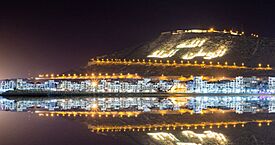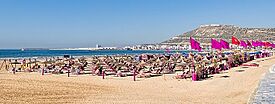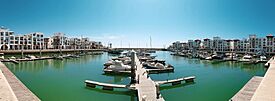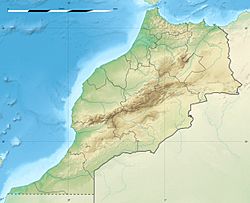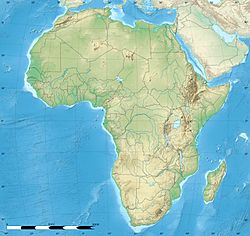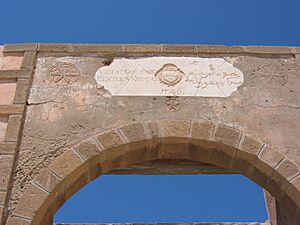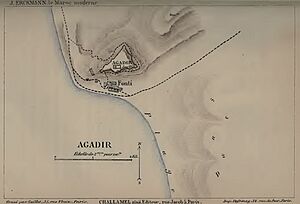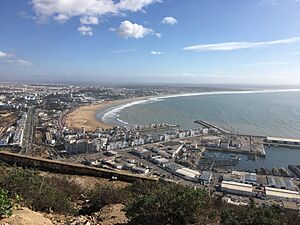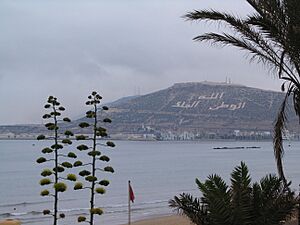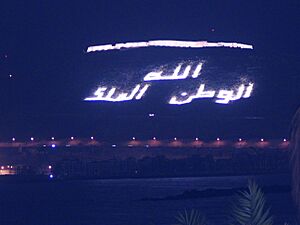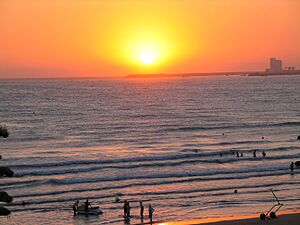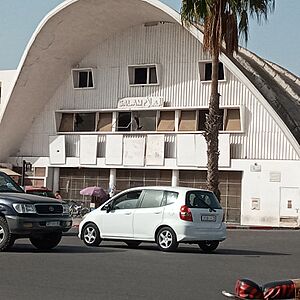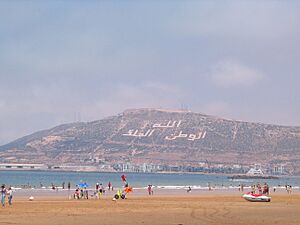Agadir facts for kids
Quick facts for kids
Agadir
|
|||
|---|---|---|---|
|
Top: View towards Agadir Oufla, Middle: View of the ocean Bottom: Agadir Marina
|
|||
|
|||
| Country | |||
| Region | Souss-Massa | ||
| Prefecture | Agadir-Ida Ou Tanane | ||
| Area | |||
| • Land | 51.2 km2 (19.8 sq mi) | ||
| Elevation | 74 m (243 ft) | ||
| Population
(2014)
|
|||
| • Total | 487,954 | ||
| • Rank | 10th in Morocco | ||
| Time zone | UTC+1 (CET) | ||
| Website | Agadir | ||
Agadir (Arabic: أكادير, romanized: ʾagādīr; Tachelhit: ⴰⴳⴰⴷⵉⵔ) is a big city in Morocco. It's located on the coast of the Atlantic Ocean, close to the Atlas Mountains. The city is about 509 kilometers (316 miles) south of Casablanca. Agadir is the capital of the Souss-Massa region.
Agadir is one of Morocco's main cities. In 2014, about 924,000 people lived in the wider Agadir area.
Agadir is known as the capital of Amazigh culture in Morocco. More than half of the people here speak Tamazight. This is one of Morocco's two official languages. The local language, Tachelhit, is spoken by many residents. Agadir also hosts many festivals celebrating Amazigh culture. These include the New Amazigh Year on January 13th and the Bilmawen Festival. There's also the Issni N’Ourgh International festival for Amazigh films. Many famous Amazigh musicians, like Izenzaren and Oudaden, come from Agadir.
The city was part of the 1911 Agadir Crisis. This event showed problems between France and Germany before World War I. Agadir was almost completely destroyed by a big earthquake in 1960. It was rebuilt with strong building rules to prevent damage from future earthquakes. Today, it's Morocco's biggest seaside resort. Tourists love its warm weather all year round. Since 2010, it's been easy to reach with cheap flights and a motorway from Tangier.
The mild winter climate makes it a popular "winter sun" spot. Many people from northern Europe visit.
Contents
What Does Agadir Mean?
The name Agadir is a common Berber word. It means 'wall,' 'fortified building,' or 'citadel.' This word is used in most Berber languages. It might come from the Tuareg word aǧādir (meaning 'wall'). It could also come from the ancient Phoenician word gadir (meaning 'wall' or 'fortress'). If the Phoenician idea is right, it's like the name of Cádiz in Spain.
Many other towns in Morocco are also called Agadir. The full name of this city in Tashelhit is Agadir Ighir. This means 'the fortress of the cape,' referring to a nearby point of land.
Agadir's Past
Early Times
The oldest map showing Agadir is from 1325. It called the area Porto Mesegina. This name came from a Berber tribe. By the end of the Middle Ages, Agadir was a well-known town. Its name, Agadir al-harba, was first written down in 1510.
Portuguese Control
In the late 1400s, the Portuguese started taking over parts of the Moroccan coast. In 1505, a Portuguese nobleman named João Lopes de Sequeira came to the area. He built a wooden castle near a spring. A Portuguese settlement called Santa Cruz do Cabo do Gué grew there. The area is still called Funti or Founti, from the Portuguese word for "fountain." The King of Portugal later bought the castle in 1513.
The local people in the Sous region didn't like the Portuguese presence. They started to block the port. In 1510, Abu Abdallah al-Qaim, a local leader, became the head of the fight against the Portuguese. His family later started the Saadi Sultanate. In 1540, the Sa'di sultan Mohammed al-Shaykh took over the main hill above the Portuguese fort. He set up artillery to attack. The siege began on February 16, 1541, and ended successfully on March 12, 1541.
Many Portuguese were captured, including the governor. After this, the Portuguese had to leave most of the Moroccan areas they had taken. By 1550, Portugal only held a few places in Morocco. They then focused on India and Brazil instead.
Moroccan Rule
After the Sa'di victory, the area was empty for a few years. Then, Abdallah al-Ghalib (who ruled from 1557–1574) built a new fort on the hilltop. It was called Agadir N'Ighir, meaning "fortified granary of the hill" in Tachelhit.
In the 1600s, Agadir became an important trading port with Europe. It traded sugar, wax, copper, and animal hides. Europeans sold weapons and textiles there. Trade with France decreased, while trade with England and the Netherlands grew.
In 1731, a big earthquake completely destroyed the town. After that, Agadir's port was closed. A new port, Essaouira, was opened further north.
Agadir's importance declined from 1760. This was because Sultan Mohammed ben Abdallah favored Essaouira. He wanted to punish the Souss region for rebelling. In 1789, a traveler described Agadir as a "ghost town" with only a few crumbling houses.
In 1881, Sultan Moulay Hassan reopened the port for trade. He needed to supply his trips to the south. These trips were to show his power over the Souss tribes.
In 1884, Charles de Foucauld wrote about Agadir. He said it looked like a city from afar but was actually a small, poor village with no trade.
On July 1, 1911, Germany sent a warship, the SMS Panther, to Agadir Bay. This was to show their interest in Morocco. This event caused the Agadir Crisis between France and Germany. It almost led to war. After talks, a treaty was signed in November 1911. France gained control over Morocco, giving up some colonies in Africa. Then, the German ships left Agadir.
In 1913, Agadir had less than a thousand people. French troops landed in Agadir on June 15, 1913. In 1916, the first simple pier was built. After 1920, under French rule, a proper port was built. The city started to grow with new areas like Talborjt.
Around 1930, Agadir was a key stop for the French airmail service Aéropostale. Famous pilots like Saint-Exupéry and Mermoz visited.
From the 1930s, a modern city center was planned and built. It was designed around the waterfront. After 1950, with the new commercial port, the city grew. Fishing, canning, farming, and mining became important. Tourism also started to grow because of the climate and hotels.
In 1959, the yacht of Aristotle Onassis visited the port. His guest was Winston Churchill.
By 1960, Agadir had over 40,000 people. But on February 29, 1960, a strong earthquake hit. It lasted only 15 seconds but destroyed almost the entire city. About 15,000 people died. The old Kasbah was also destroyed.
Agadir After 1960
The new city was rebuilt about 1.6 kilometers (1 mile) south of the old one. Architects like Jean-François Zevaco and Elie Azagury helped design it. Le Corbusier also gave advice. Agadir grew into a big city with over half a million people by 2004. It has a large port with different areas for trade, fishing, and pleasure boats. In the 1980s, Agadir was the world's top sardine port. It has a beautiful beach over 10 kilometers long. The city gets 340 days of sunshine each year, so you can swim all year. Winters are warm, and summers can be hazy.
Agadir is a very important place for tourism in Morocco, like Marrakech. It's also the country's main fishing port. Business is good with exports of citrus fruits and vegetables from the fertile Souss valley.
On December 12, 2022, a smaller earthquake (magnitude 4.5) hit off the coast of Agadir.
Agadir's Location and Areas
Agadir is actually made up of four main areas:
- The old Agadir city
- The urban area of Anza
- The rural towns of Bensergao
- The rural towns of Tikiwine
New Talborjt
This area is named after the old Talborjt district. Talborjt means "small fort" in Berber. The new Talborjt was rebuilt away from the old one. Its main street is Boulevard Mohammed Sheikh Saadi, named after the leader who defeated the Portuguese in 1541. Other important streets are Avenue President Kennedy and Avenue 29 February. You can find the Mohammed V mosque, the Olhão garden (named after a twin city in Portugal), and the Garden Ibn Zaydoun here. There are also nice hotels and restaurants.
Residential Areas
- Swiss Village: This is the oldest area with villas.
- Mixed Sector District (THE NEW IHCHACH): The French and Spanish Consulates are here.
- Founty or "Bay of palm trees": A beachside area with villas, big hotels, and the royal palace.
- High Founty: A new area with buildings and villas, near the new city center.
- Illigh: An area with large villas, where many wealthy families live.
- Charaf: Hassan II hospital is in this district.
- Les Amicales: Also called the "city of government employees."
- Dakhla: Near Ibn Zohr University, with modern buildings and apartments.
- Hay Mohammadi: A new area with villas and large buildings.
- Adrar City: A new district next to the Metro hypermarket.
- Other neighborhoods: Amsernat, Lakhyam, Erac Bouargane, Massira, Essalam, Tilila, Tassila, Bensergao, Riad Assalam, Islane, Ihchach (Yachech) Nahda, Anza, Assaka, Bir Anzarane, Tikouine, Zaitoune, Taddart and El Houda.
The Casbah
The Casbah (also called Agadir Oufla or Agadir N'Ighir) was one of the oldest parts of Agadir. It was a real fortress with winding streets. The Casbah was built in 1572 by Abdallah al-Ghalib. Above its front door, you can still see the words: "God, the Nation, the King."
After the 1960 earthquake, only a long, high wall of the fortress remains. You can't build on this land. However, it offers amazing views of Agadir Bay and the ports. Older residents remember the "Moorish café" in the Casbah and its great view.
The hill has the Arabic words "God, Country, King" written on it. These words light up at night.
Old Talborjt
This old area used to be a busy shopping place. It had a big square with a weekly market, hotels, schools, and a mosque. The 1960 earthquake destroyed most of Old Talborjt. It was leveled and is now an empty, overgrown area where building is not allowed. Its main street is used for driving lessons.
Souk El Had
This is the biggest market in the region. It has about 6,000 small shops. It's surrounded by walls and has many entrances. The market is divided into sections for furniture, crafts, clothes, vegetables, meat, and spices. You can find all kinds of traditional crafts and decorations here.
The market walls have been fixed, and the inside is being updated.
La Médina
La Médina is a special place for handicrafts. It was created in 1992 by Italian artist Coco Polizzi. It's in Ben Sergao, about 4.5 kilometers (2.8 miles) from the city center. It's built using traditional Berber methods. It's like a small outdoor museum, covering five hectares. It has artisan workshops, a museum, homes, a small hotel, and an exotic garden.
Agadir's Climate
Agadir has a semi-arid climate. This means it has warm summers and mild winters. Because it's on the Atlantic Ocean, Agadir's weather is very mild. Daytime temperatures usually stay in the 20s °C (70s °F). In January, the average high is about 21 °C (70 °F).
Most rain falls in the winter months. Sometimes, hot winds from the Sahara, called Chergui, blow. These can raise the temperature above 40 °C (104 °F) for a few days. On August 12, 2023, Agadir recorded a very high temperature of 50.4 °C (122.7 °F). This makes it one of the few coastal places in the world to reach over 50 °C.
In 1950, a travel poster said: "Winter or summer, I bathe in Agadir."
| Climate data for Agadir (Inezgane) (1991–2020) | |||||||||||||
|---|---|---|---|---|---|---|---|---|---|---|---|---|---|
| Month | Jan | Feb | Mar | Apr | May | Jun | Jul | Aug | Sep | Oct | Nov | Dec | Year |
| Record high °C (°F) | 31.9 (89.4) |
36.0 (96.8) |
38.2 (100.8) |
40.0 (104.0) |
46.1 (115.0) |
46.7 (116.1) |
48.5 (119.3) |
50.4 (122.7) |
43.5 (110.3) |
42.6 (108.7) |
38.0 (100.4) |
33.6 (92.5) |
50.4 (122.7) |
| Mean daily maximum °C (°F) | 21.2 (70.2) |
22.0 (71.6) |
23.4 (74.1) |
23.2 (73.8) |
24.2 (75.6) |
25.6 (78.1) |
26.7 (80.1) |
27.0 (80.6) |
26.1 (79.0) |
26.1 (79.0) |
24.1 (75.4) |
22.1 (71.8) |
24.3 (75.8) |
| Daily mean °C (°F) | 14.8 (58.6) |
16.1 (61.0) |
17.9 (64.2) |
18.7 (65.7) |
20.1 (68.2) |
21.9 (71.4) |
23.0 (73.4) |
23.3 (73.9) |
22.3 (72.1) |
21.4 (70.5) |
18.5 (65.3) |
16.1 (61.0) |
19.5 (67.1) |
| Mean daily minimum °C (°F) | 8.4 (47.1) |
10.1 (50.2) |
12.3 (54.1) |
14.1 (57.4) |
15.9 (60.6) |
18.1 (64.6) |
19.2 (66.6) |
19.5 (67.1) |
18.6 (65.5) |
16.7 (62.1) |
12.9 (55.2) |
10.1 (50.2) |
14.7 (58.4) |
| Record low °C (°F) | 1.1 (34.0) |
2.4 (36.3) |
5.3 (41.5) |
4.4 (39.9) |
8.9 (48.0) |
12.9 (55.2) |
13.0 (55.4) |
14.6 (58.3) |
12.1 (53.8) |
9.5 (49.1) |
1.6 (34.9) |
2.2 (36.0) |
1.1 (34.0) |
| Average precipitation mm (inches) | 32.0 (1.26) |
28.6 (1.13) |
31.3 (1.23) |
13.8 (0.54) |
5.6 (0.22) |
0.8 (0.03) |
0.2 (0.01) |
3.1 (0.12) |
3.7 (0.15) |
21.2 (0.83) |
42.3 (1.67) |
49.0 (1.93) |
231.6 (9.12) |
| Average precipitation days (≥ 1 mm) | 2.8 | 2.7 | 3.2 | 1.7 | 0.8 | 0.2 | 0.1 | 0.3 | 0.5 | 1.9 | 3.0 | 3.6 | 20.8 |
| Mean monthly sunshine hours | 234.6 | 224.8 | 266.8 | 273.5 | 297.1 | 266.8 | 252.7 | 247.6 | 234.5 | 242.2 | 228.1 | 221.8 | 2,990.5 |
| Percent possible sunshine | 74 | 73 | 73 | 71 | 71 | 64 | 59 | 61 | 64 | 70 | 73 | 71 | 68 |
| Source: NOAA (sun 1981–2010), (February record high) | |||||||||||||
Agadir's Economy
Agadir's economy mainly depends on tourism and fishing. Farming is also important in the areas around the city. Agadir has one of the biggest markets in Morocco, called Souk El Had.
The fishing port is a major center for sardines. The commercial port is also known for sending out cobalt, manganese, zinc, and citrus fruits. The Avenue du Port has many canning factories and small restaurants near the fish market. There's also a shipyard and Morocco's only merchant marine school in the port.
Agadir is served by Al Massira Airport, which is about 14 kilometers (8.7 miles) from the city.
Culture and Fun in Agadir
The Timitar festival is held in Agadir every summer. It celebrates Amazigh culture and music from all over the world. It started in July 2004.
The Morocco Movement group supports arts and organizes concerts and exhibitions. These include visual arts, design, music, and photography.
Other cultural events in Agadir are:
- Noiz Makerz urban music concert.
- Breaking South national break-dancing championship.
- International Documentary Film Festival in November (FIDADOC).
- Film Festival for immigration.
- International Festival of University Theatre of Agadir.
- Concert for Tolerance (November).
- Festival of Laughter.
- International Salon of Art of Photography (Clubphoto d'Agadir).
Museums to Visit
- Musée de Talborjt "La Casbah"
- Musée Bert Flint
- Le Musée des Arts Berberes (Berber Arts Museum)
- Musee Municipal de Agadir (City Museum)
- La Medina d'Agadir
Learning in Agadir
Agadir has a university called Ibn Zohr University. It has faculties for science, medicine, law, economics, and arts.
There are also other higher education schools like:
- The National School of Applied Sciences (ENSA).
- The National School of Business and Management (ENCG).
- The Graduate School of Agadir Technology (ESTA).
Agadir has international French schools and public schools. High schools include Lycée Lala Meryem Agadir and Lycée Qualifiant Youssef Ben Tachfine.
Sports in Agadir
Agadir has a football (soccer) club called Hassania Agadir. The team plays its home matches at the new Adrar Stadium. The city also has the Royal Tennis Club of Agadir. It might even host matches for the 2030 FIFA World Cup.
Golf tournaments like the Hassan II Golf Trophy and Lalla Meryem Cup are held at the Golf du Palais Royal in Agadir.
Football
- Hassania Agadir
Taekwondo
- Association club El johara
- Association club central
Other Sports
- Royal Tennis Club Agadir
- Najah Souss Agadir
- Cité Suisse Basket
- Agadir Surf Academy
- Water Skiing Club Agadir
Famous People from Agadir
- Mohamed Bensaid Ait Idder, Moroccan politician
- Sion Assidon, Moroccan activist
- Walid Azaro, Moroccan footballer
- Abdelkrim Baadi, Moroccan footballer
- Jacques Bensimon, Canadian filmmaker
- Issam Chebake, Moroccan footballer
- Mohamed Choua, Basketball player
- Jalal Daoudi, Moroccan footballer
- Karim El Berkaoui, Moroccan footballer
- Hicham El Majhad, Moroccan footballer
- Omar Hilale, Moroccan ambassador to the United Nations
- Pokimane, Moroccan-Canadian Internet personality
- Saadia Himi, Miss Netherlands Earth 2004 (has roots in Agadir)
- Hassan Kachloul, former Moroccan football player
- Mohammed Khaïr-Eddine (1941–1995), Moroccan writer
- Moncef Slaoui, Moroccan-Belgian doctor and researcher
Beaches Near Agadir
Some of Morocco's most popular beaches are north of Agadir. Areas like Taghazout village are famous for surfing.
Many smaller, clean beaches are found along this coast. Some of them between Agadir and Essaouira include: Agadir Beach, Tamaounza (12 km away), Imouran (17 km away), Taghazout (19 km away), and Aghroud (30 km away).
Main Sights in Agadir
- Agadir Crocodile park
- The view of the city and bay from Agadir Oufla (Casbah)
- Valley of the Birds, a nice bird park
- The garden of Ibn Zaidoun
- Mohammed V Mosque
- Souk el Had (The biggest Market in Africa)
- Amazigh (Berber) Heritage Museum
- The garden of Olhão and its memorial museum
- The marina with its shops
- Loubnane Mosque
- Wall of commemoration
- Memory of Agadir Museum; shows photos and exhibits about the 1960 earthquake
Nearby Places to Visit
- The city of Taroudannt (80 km east)
- Palm Oasis of Tiout (100 km from Agadir)
- Imouzzer Ida Ou Tanane (60 km northeast), where Paradise Valley is located
- The beaches of Taghazout and Tamraght.
- The city of Tiznit (90 km south) and Tafraout (80 km from Tiznit), known for pink granite rocks
- The Souss-Massa National Park and Oued Massa (about 70 km south)
- Legzira beach with amazing natural arches (150 km south)
- Sidi Ifni (160 km south on the coast)
- The city of Essaouira (175 km north on the coast)
- Dephinarium Agadir Dolphin World Morocco
Movies Filmed in Agadir
- 1934: Le Grand Jeu
- 1954–1955: Oasis
- 1969: Du soleil plein les yeux
- 1988: Y'a bon les blancs
- 2006: Days of Glory
- 2009: "Les Filles du désert" (an episode of Plus belle la vie)
- 2011: Agadir Bombay
Agadir in Books and Art
- Agadir: a book by Moroccan writer Mohammed Khaïr-Eddine
- Ride to Agadir: a song by Mike Batt, also covered by Boney M.
Sister Cities
Agadir has eight sister cities:
 Mar del Plata, Argentina
Mar del Plata, Argentina Miami, United States
Miami, United States Oakland, United States
Oakland, United States Portsmouth, New Hampshire, United States
Portsmouth, New Hampshire, United States Olhão, Portugal
Olhão, Portugal Nantes, France
Nantes, France Stavanger, Norway
Stavanger, Norway Shiraz, Iran
Shiraz, Iran Vigan, Philippines
Vigan, Philippines
Agadir also has a cooperation agreement with:
 Lyon, France
Lyon, France
Images for kids
See also
 In Spanish: Agadir para niños
In Spanish: Agadir para niños


